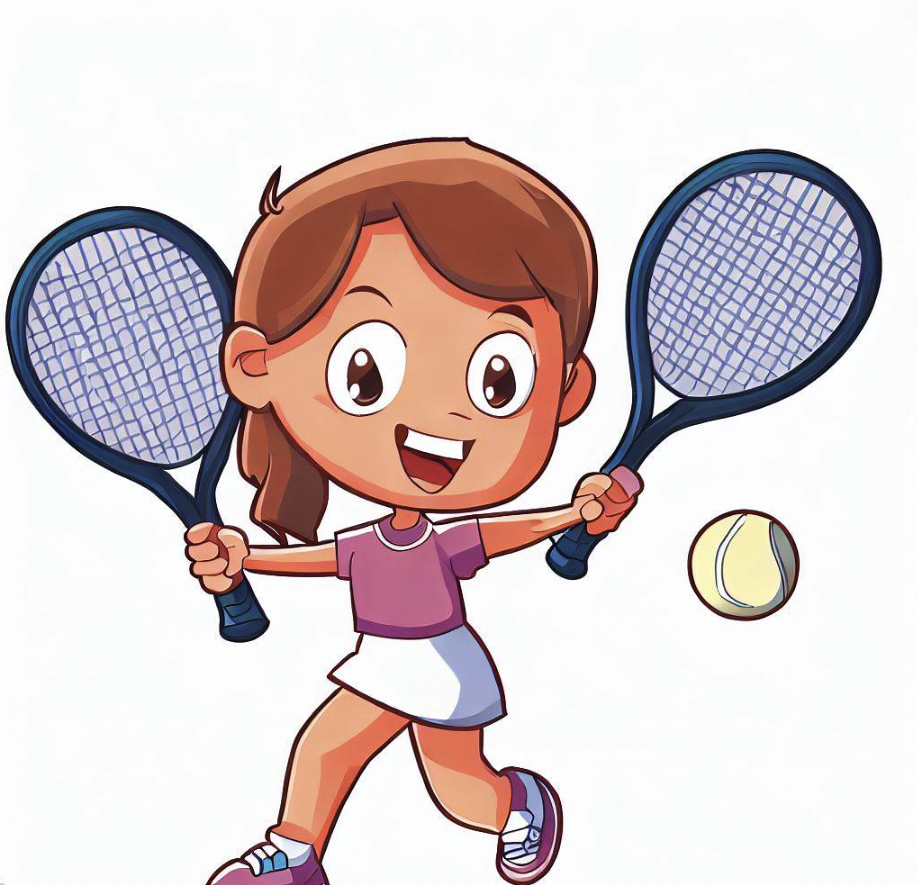Understanding the dynamics of doubles tennis is the first step to effective strategy.
Unlike singles tennis, doubles tennis involves two players per side, making it a game not only of skill but also of teamwork.
You’re not just playing the ball; you’re playing in conjunction with your partner, exploiting the increased court coverage, and synchronizing strategies to outplay your opponents.
This necessitates good communication, coordination, and a keen understanding of each other’s playing styles.
Doubles Tennis Formations
In doubles tennis, there are several common formations that players use to position themselves strategically on the court.
Here are some of the most popular doubles formations:
Traditional Formation (Up/Back)
In this formation, one player stands at the net (up) and the other player positions themselves at the baseline (back).
The player at the net is typically more skilled in volleying and has quick reflexes, while the player at the baseline focuses on hitting powerful groundstrokes.
Australian Formation
Also known as the “Poach Formation,” this strategy is used to confuse the opponents.
The net player on the serving team stands on the opposite side of the court, diagonally across from their partner at the baseline.
The purpose is to anticipate and intercept the opponent’s return shot.
I Formation
In this formation, both players stand on the same side of the court, with one player at the net and the other player positioned at the baseline.
The net player typically stands closer to the center of the court.
The purpose of this formation is to confuse the returner and create openings for the net player to poach or intercept shots.
Australian I Formation
This formation is a variation of the I Formation, where the server’s partner (net player) stands on the opposite side of the court, similar to the Australian Formation.
The server can choose to serve from either side of the court, adding an element of surprise to the opponents.
2-Back Formation
In this formation, both players position themselves at the baseline.
It is commonly used when the opponents’ shots are difficult to volley, or when players want to focus on powerful groundstrokes and defensive play.
2-Up Formation
This formation involves both players taking positions at the net.
It is often used when players want to put pressure on their opponents by cutting off angles and forcing them to hit difficult passing shots.
These are just a few of the many formations that doubles tennis players employ.
The choice of formation can vary depending on the players’ strengths, game plan, and the specific situation during the match.
Doubles Strategy Do’s And Don’ts (Win More Tennis Matches)
The Serve Strategy
Serving in doubles tennis requires precision, strength, and strategic placement.
The server should aim to serve wide to stretch the opposing team and create space for the partner to exploit.
A high percentage of first serves into play is also critical because it puts pressure on the returners and helps avoid second serve attacks.
Also, vary the speed and spin on your serves to keep your opponents guessing.
A well-placed serve often can be more effective than sheer power.
The Return Strategy
Returning in doubles tennis requires the ability to react quickly and direct the ball with purpose.
It’s best to aim your returns at the server’s feet or down the middle of the court to reduce angles for the net player.
If the serving team employs a serve-and-volley strategy, a low, fast return can disrupt their rhythm.
Lastly, good returns can put the server on the defensive from the start, giving you and your partner the advantage.
Net Play Strategy
Net play is essential in doubles tennis. The team that controls the net generally controls the point.
This is because a player at the net can cut off more angles and put pressure on the opponents, forcing them to make difficult shots.
Good volleying skills are a prerequisite for effective net play. However, beware of lob shots from your opponents; quick reflexes and good overhead smashes will counter this.
How To Poach Like A Pro (Advanced Tennis Doubles Strategy)
Communication and Teamwork
Effective communication forms the backbone of any successful doubles tennis strategy.
Partners should constantly talk to each other, discussing strategy, calling shots, and providing encouragement.
You can even use hand signals at the competitive level.
Good teamwork involves understanding each other’s strengths and weaknesses, and covering for each other on the court.
Remember, doubles tennis is a team sport, and the most successful teams are those that work together effectively.
The Importance of Positioning
Proper positioning on the court can often be the difference between winning and losing a point.
In general, the server’s partner should position themselves close to the net, ready to intercept returns, while the server should be ready to cover the baseline.
This is often referred to as the “up-and-back” formation. Other times, both players may choose to be at the net, known as the “both-up” formation.
Understanding when to use each formation can give a team the upper hand.
Adapting to Your Opponents
Lastly, a crucial part of doubles tennis strategy is being adaptable.
Each opponent will have different strengths, weaknesses, and tendencies.
Paying attention to these details and adjusting your strategy accordingly can often make the difference.
For example, if an opponent has a weak backhand, aim to exploit it.
If they struggle with low volleys, make them play as many as possible.
Conclusion
Doubles tennis strategy involves much more than individual skill.
It’s a complex, dynamic game that requires a good understanding of the sport’s intricacies, excellent communication and teamwork, proper positioning, and adaptability.
Mastering these elements can greatly enhance your performance on the court and make doubles tennis a rewarding experience.
FAQs – Tennis Doubles Strategy
1. What is the difference between singles and doubles strategy in tennis?
In singles tennis, a player competes against one opponent, while in doubles tennis, two teams of two players each compete against each other.
Doubles strategy involves different positioning, shot selection, and communication between partners compared to singles strategy.
2. What are the key elements of a successful doubles strategy?
Key elements of a successful doubles strategy include effective communication, good court positioning, teamwork, and utilizing specific shot selections such as lobs, volleys, and overhead smashes.
It also involves understanding each player’s strengths and weaknesses and capitalizing on them.
3. How should I position myself on the court while playing doubles?
Positioning in doubles is crucial.
Generally, players adopt a formation where one player stays near the net (the “net player”) and the other player stays closer to the baseline (the “baseline player”).
The net player aims to intercept shots hit by the opponents, while the baseline player covers the deep shots and supports the net player when needed.
4. What are some common doubles formations?
Common doubles formations include:
- Traditional Formation: In this formation, the net player stands at the center of the net, while the baseline player stays near the baseline. This formation allows the net player to cover most of the shots hit by the opponents.
- Australian Formation: In this formation, the net player stands on the same side as the server, slightly shifted towards the center. The baseline player stands diagonally opposite the net player. This formation can disrupt the returner’s rhythm.
- I-Formation: In this formation, the net player stands at the center of the service line, and the baseline player positions themselves near the baseline. This formation can confuse the opponents by masking the intended serving direction.
5. How important is communication in doubles tennis?
Communication is crucial in doubles tennis. Effective communication between partners allows them to coordinate their movements, call shots, and discuss strategies.
It helps avoid confusion, prevents collisions, and ensures that both players are on the same page during the match.
6. When should I use a lob shot in doubles?
Lob shots are useful in doubles when your opponents are near the net or have approached the net.
A well-executed lob can force the opponents to retreat and buy time for you to regroup and reposition yourself on the court.
It can also be effective when the net player is aggressive and consistently poaching at the net.
7. What is the importance of serving well in doubles?
Serving well in doubles is essential because a good serve can put your opponents on the defensive right from the start.
It can set the tone for the point and allow you to gain control of the rally.
A strong serve can also create opportunities for your partner to intercept the return and dominate the net.
8. How can I effectively work with my partner as a team?
To work effectively with your partner as a team, you should:
- Communicate openly and frequently.
- Establish clear roles and responsibilities for each player.
- Cover each other’s weaknesses and play to each other’s strengths.
- Anticipate and support your partner’s movements on the court.
- Stay positive and encourage each other, even during challenging moments.
- Practice together to develop an understanding of each other’s playing style.
9. What strategies can I use to break my opponents’ serve in doubles?
To break your opponents’ serve in doubles, you can:
- Focus on returning deep and low to make it harder for the server to attack.
- Look for opportunities to angle your returns to force the server out of position.
- Employ a variety of shot placements to keep the server guessing.
- Use effective court positioning to cut off angles and pressure the server into making errors.
- Coordinate with your partner to apply pressure at the net and force weak responses from the server.
10. How can I improve my net play in doubles?
To improve your net play in doubles, you can:
- Work on your volleying skills to be comfortable and confident at the net.
- Anticipate your opponents’ shots by reading their body language and racquet position.
- Practice quick reflexes and agility to react to fast-paced shots.
- Learn to poach effectively by intercepting your opponents’ shots intended for your partner.
- Master the art of positioning at the net to cover angles and create pressure on your opponents.


